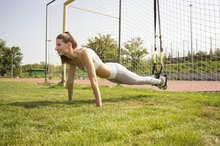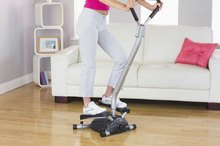How to Run After a Herniated Disc
The bones of the spine or vertebra are separated in part by structures called discs. These discs are circular with a jelly like center and they help to provide cushioning and allow movement. With age and wear and tear, the discs naturally lose some of their fluid and they begin to shrink. This can cause the disc to herniate, which means the jelly like center is bulging out of place. Disc herniations can also be the result of an accident or disease such as arthritis.
In some cases a herniated disc can exist without ever causing any symptoms, while in others this condition is debilitating.
Before attempting to run with a herniated disc it is important to seek medical advice, because in some cases running may be contraindicated. If a physician does give the OK, some guidelines may help to prevent complications.
Stretch the back muscles before and after running. The symptoms of a herniated disc can be exacerbated by tight back muscles, which can pull on the spine. If the muscles are tight, they can cause poor posture and contribute to a herniated disc. In addition, the constant pounding of running can place excessive force on the spine and make the back muscles tighten even more.
Gently stretching the back before and after running, will keep the back muscles limber and help correct posture, both of which will take pressure off the disc, states the American Academy of Family Physicians. It is best to work with a physical therapist when designing a program, however movements such as hugging the knees to the chest and dropping both knees to the side can both help to stretch the back. Stretches should be done slowly and be held for at least 30 seconds to allow the muscles to relax. To avoid further injury never bounce while stretching.
Back Pain While Walking
Learn More
Do the bridge exercise. Along with stretching the back it is important to strengthen the back muscles and the bridge exercise can do just that. Start by lying on the back with the knees bent and feet flat. Tighten the abdominal and buttocks muscles and lift the buttocks and low back up off the floor. Then slowly lower down. Do eight to 12 repetitions and to make the movement more challenging, try keeping one leg up in the air. The MayoClinic.com suggests doing the bridge to help strengthen the back, which will stabilize the spine and trunk during all activities, including running.
Cross train. Repetitive twisting and bending exercises or sports that expose the body to vibration such as running, can contribute to the development of a herniated disc, warns Cedars-Sinai. For this reason, it is important to cross train, which means doing a variety of activities. To avoid placing excessive strain on the back alternate days of running with a no impact activity, such as biking and swimming. This will help to keep the body strong while not overloading the spine.
Activities to Avoid With Spinal Stenosis
Learn More
Do crunches. When the abdominal muscles are weak, the back muscles must work even harder, which over time can lead to a herniated disc. Keeping the abdominal muscles strong will help to take pressure off the back when running.
Try lying on the back with the knees bent and feet flat. Place the fingertips behind the head and lift the head and shoulders straight up off the floor, just until the muscles contract. Then lower down slowly. Repeat for eight to twelve repetitions and make sure that the abdominal muscles are contracting. This exercise should not cause neck or back pain.
Run in the water. If a herniated disc is causing too much pain to run on land, try deep water jogging to help the body get stronger. There are flotation belts that go around the waist that hold the body upright. Keep the feet off the pool floor and mimic a running motion with the arms and legs. Work on pushing the body through the water to create resistance. Deep water running is a great way to get the benefits of running without the impact of running on land.
Tips
Always check with a doctor or physical therapist before starting any exercise program for a herniated disc. Listen to your body to know when the level of exercise is too much.
Warnings
Stop any exercise that makes back pain worse or causes numbness and tingling. Exercise should make you feel better, not worse.
Related Articles
References
- American Academy of Family Physicians: Herniated Disk: What It Is and What You Can Do
- MayoClinic.com: Lifestyle and Home Remedies:
- Cedars-Sinai: Herniated or Ruptured Disc
- American Association of Neurological Surgeons. Herniated disc.
- American Academy of Orthopedic Surgeons. Herniated disk in the lower back. Updated June 2018.
- Battié MC, Videman T, Kaprio J et al. The Twin Spine Study: Contributions to a changing view of disc degeneration. Spine J 2009;9(1):47-59. doi:10.1016/j.spinee.2008.11.011
- Amin RM, Andrade NS, Neuman BJ. Lumbar disc herniation. Curr Rev Musculoskelet Med. 2017;10(4):507-16. doi: 10.1007/s12178-017-9441-4
- Shin JS, Lee J, Lee YJ, et al. Long-term course of alternative and integrative therapy for lumbar disc herniation and risk factors for surgery: A prospective observational 5-year follow-up study. Spine. 2016;41(16):E955-63. doi:10.1097/BRS.0000000000001494
- Schoenfeld AJ, Weiner BK. Treatment of lumbar disc herniation: Evidence-based practice. Int J Gen Med. 2010;3:209-14.
Resources
Writer Bio
I hold a Master's degree in exercise physiology/health promotion. I am a certified fitness specialist through the American College of Spots Medicine and an IYT certified yoga teacher. I have over 25 years experience teaching classes to both general public and those with chronic illness. The above allows me to write directly to the reader based on personal experiences.









